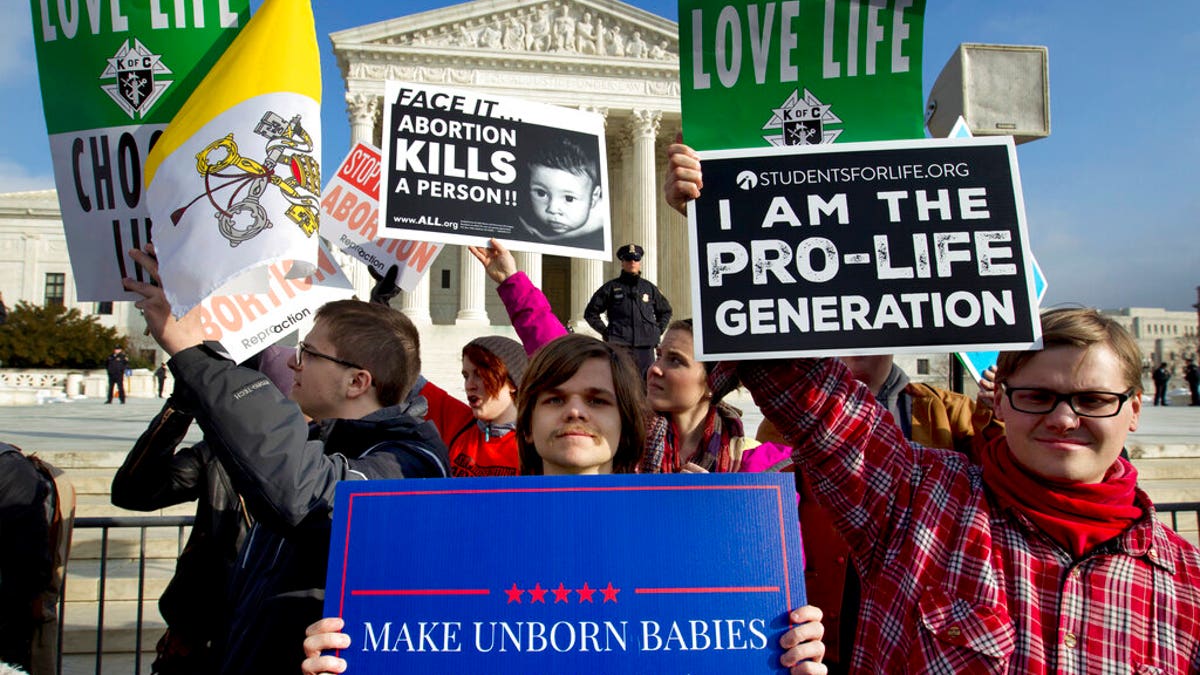Heated protests outside Supreme Court ahead of abortion decision
A pro-choice protester confronts pro-life protesters praying outside the Supreme Court.
More than 63 million abortions are estimated to have taken place in the U.S. since the Supreme Court's 1973 Roe v. Wade ruling that granted federal protections to women seeking to terminate their pregnancies, according to one analysis.
The National Right to Life Committee (NRLC), the nation's oldest pro-life organization, estimates that 63,459,781 abortions have taken place since 1973. That estimate was gathered by tracking data from the Centers for Disease Control and Prevention (CDC) and the Guttmacher Institute, which previously served as a research arm of the nation's preeminent abortion provider, Planned Parenthood.
A draft opinion written by Justice Samuel Alito that would overturn Roe v. Wade and return the issue of abortion to individual states was leaked to Politico on Monday.
"We hold that Roe and Casey must be overruled," Alito wrote in a February draft opinion for the case Dobbs v. Jackson Women's Health Organization. "It is time to heed the Constitution and return the issue of abortion to the people’s elected representatives."
SUPREME COURT SET TO OVERTURN ROE V. WADE, LEAKED DRAFT OPINION SHOWS: REPORT

Pro-abortion rights activists protest outside the Supreme Court building, ahead of arguments in the Mississippi abortion rights case, in Washington, Dec. 1, 2021. (Reuters/Jonathan Ernst)
The recently updated data from the NRLC states that for every 1,000 live births, there are 195 abortions. That number, however, is lower than the 196.3 in 1973, Roe's first year in effect.
"In its twin Roe v. Wade and Doe v. Bolton decisions, which were handed down on Jan. 22, 1973, the court legalized abortion for any reason," said NRLC President Carol Tobias. "Tragically, 49 years later, National Right to Life estimates that more than 63 million unborn children have lost their lives as a result of those decisions."
Much of the debate surrounding abortion has tended toward discussions about rights and when life begins. Among varying ideas advanced by the left, former Planned Parenthood CEO Cecile Richards has argued that "there's no specific moment when life begins" and that hers began when her children were born.

Fetus ultrasound (iStock)
According to the U.S. National Library of Medicine, an unborn baby's toes can be seen and its lungs, ears, eyes, arms and legs start to form before the end of the first trimester. Between nine and 12 weeks after conception, a baby's face becomes well-formed, genitals appear, and nails appear on the fingers and toes.
"Through our determination to protect mothers and their children, we continue to see evidence that our efforts to educate our nation about the unborn child’s humanity, and our efforts to enact protective pro-life legislation, are having a tremendous impact in moving our nation away from Roe and Doe’s deadly legacy," Tobias said.
Most women who got an abortion in 2014 were low income, with 49% having an income at or below the poverty line (which was $11,000 for an individual that year) and 26% with an income of twice the poverty line or less, according to a 2016 Guttmacher study. Most women who obtained abortions were in their 20s (60%), and about a third were in their 30s.
More than half of abortions in 2014 (59%) were obtained by women who had at least one child, according to Guttmacher.
Compared to the demographics of the whole U.S. population, Black women were "substantially overrepresented" among those obtaining abortions in 2014, Guttmacher said. Thirty-nine percent of women who obtained abortions in 2014 were White, while 28% were Black, 25% were Hispanic, and 6% were Asian or Pacific islander.

Anti-abortion activists protest outside the U.S. Supreme Court during the March for Life in Washington on Jan. 18, 2019. (AP Photo/Jose Luis Magana)
Citing statistics from the CDC, NRLC noted that abortion ratios peaked at 364.1 abortions for every 1,000 live births in 1984, but dropped to 245 per 1,000 live births by the time the abortion pill was approved for use in September 2000.
According to Guttmacher, between 1975 and 2012, the nation saw more than one million abortions each year. Guttmacher also found that of the women who had abortions in 2014, 62% reported a religious affiliation – 24% were Catholic, 17% were mainline Protestant, 13% were evangelical Protestant and 8% identified with some other religion.
CLICK HERE TO GET THE FOX NEWS APP
Provided to Fox News Digital on Tuesday, a fact sheet from the NRLC estimates that "18 states would protect unborn children immediately" if Roe v. Wade is overturned by the Supreme Court. Those moves, according to the NRLC assessment, would come through state laws implemented prior to the Roe v. Wade ruling, "trigger" laws that would go into effect following the reversal, or both.
On the contrary, NRLC estimates that 22 states would move to "allow abortion either through legislatively-enacted statute or court ruling interpreting the state constitution to convey the right to abortion."
Fox News' Thomas Phippen contributed to this report.





















